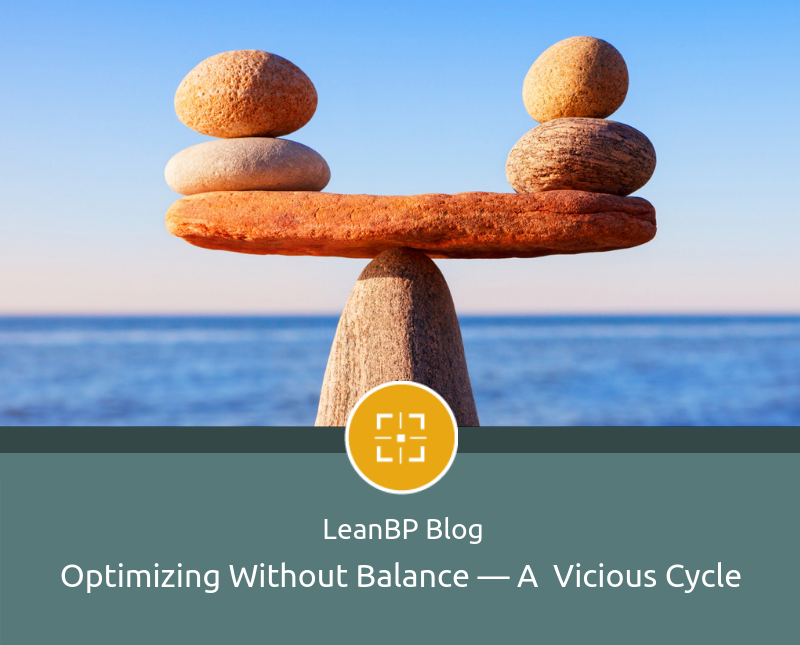 It’s counterintuitive to think that maximizing your job or your department’s throughput can have a detrimental effect on your company. But that’s exactly the problem leaders face in running the modern organization. And once the problem starts, it creates a vicious cycle that quickly gets out of control.
It’s counterintuitive to think that maximizing your job or your department’s throughput can have a detrimental effect on your company. But that’s exactly the problem leaders face in running the modern organization. And once the problem starts, it creates a vicious cycle that quickly gets out of control.
Optimizing without a balancing metric is a dangerous thing.
Thanks to today’s organizational structure, which creates isolated functional silos, we have millions of leaders out there optimizing their own departments—without considering the needs of the organization as a whole. They apply great effort and ingenuity to optimizing in isolation, without using any kind of balancing metric to assess whether that optimization has a net effect on the organization’s productivity.
This is what optimizing in isolation looks like as a culture:
- Ramping up production at the expense of safety, compliance, quality, and even profit.
- Increasing sales revenue at the expense of profitable orders.
- Increasing the quantity and speed of sales orders at the expense of quality orders for production.
- Cutting costs at the expense of good customer service.
- Increasing management’s situational awareness (that is, having more meetings and requiring more reporting) at the expense of production.
- Planning at the expense of execution and executing at the expense of planning.
- Tightening purchasing budget discipline at the expense of parts availability.
- Requiring more end-of-period reporting for CEOs/CFOs at the expense of long-term planning.
- Optimizing this month’s/quarter’s metrics at the expense of future metrics.
- Increasing HR, legal, and regulatory compliance at the expense of speed and flexibility.
How Did We Get Here?
This culture did not arise suddenly; rather, it has evolved over decades. And it persists especially in organizations that enjoy limited competition due to government regulations, a high cost of market entry, the United States’ unique competitive position after World War II, etc.
- Workers and departments are rewarded when their individual metrics show improvement, but because they haven’t taken any balancing metrics into account, there’s no improvement in profitability. Everyone seems to be performing optimally, with no measurable results. As a consultant and teacher, I’ve worked with customer service call centers whose representatives were rated for speed and customer satisfaction—but not accuracy. I’ve seen workers measured on their ability to complete customer requests within three days—which caused them to give up on anything taking longer because their metrics had already taken a hit. And the list goes on.
- This lack of profitability leads to blaming and finger-pointing. Finally, the finance department is put in charge to save the organization. Finance can’t run the operation any better, but they must now find ways to cut in order to survive—usually payroll. That in turn cuts broad swaths of capacity, capability, and customer service.
- Leadership spends more time engineering financial reports and metrics than engineering better products and services for the customer. (I credit New York Times columnist Thomas Friedman for articulating this idea: click here for his take.) Or, in the worst-case scenarios—think WorldCom and Enron—they resort to misleading or fraudulent reporting, or cutting corners on safety and compliance, which gets regulatory agencies involved (Sarbanes-Oxley, OSHA, EPA, EEOC, etc.). Once that happens, the drastic and rapid changes necessary to bring the organization back into compliance will adversely affect production.
This situation is, of course, unsustainable.
The final outcome is typically a reorganization (or worse, a bankruptcy) . . . after which new metrics are optimized again without balance. In the aftermath of a reorg, there’s a honeymoon period where a necessary learning curve is assumed and no one can be held accountable for anything. And thus the whole cycle starts over again.
This endless pattern creates fear and confusion in the workplace. Good people either get cut blindly due to seniority or jump ship for a better work environment.
How do you stop the cycle? Change the culture of local optimization before draconian steps are required. Lean Applied to Business Processes (LABP) is an organized methodology for doing that, focusing on the biggest constraint to the organization’s goal while looking across functional silos. It starts with articulating, documenting, and communicating your goal—by defining the why, the what, and the how. This goal must be balanced and then translated for each department and to every level.
